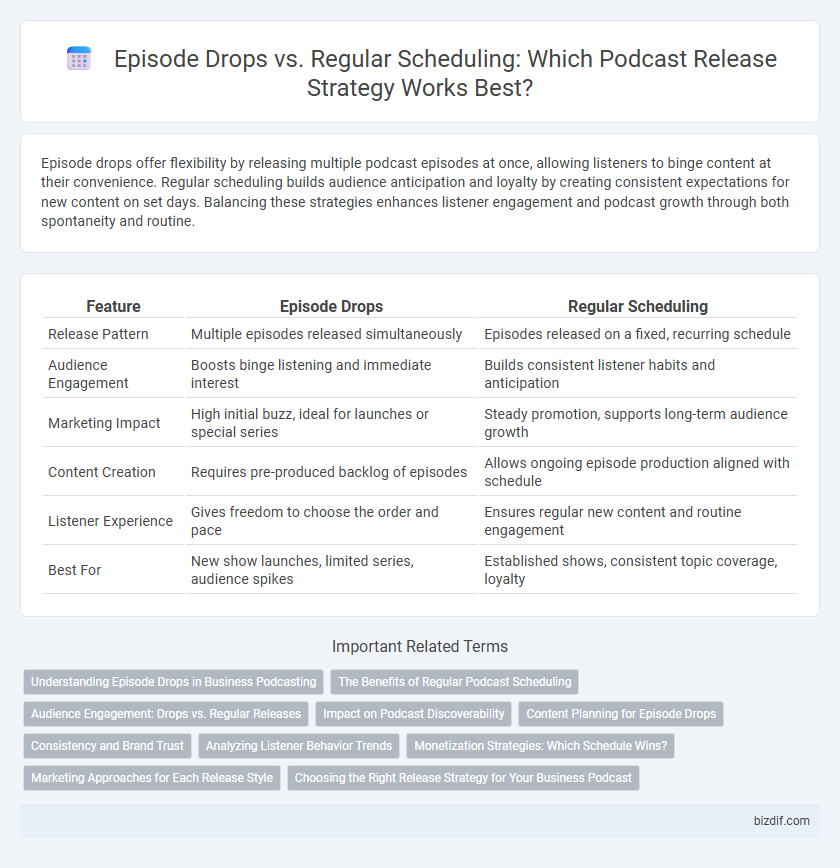Episode drops offer flexibility by releasing multiple podcast episodes at once, allowing listeners to binge content at their convenience. Regular scheduling builds audience anticipation and loyalty by creating consistent expectations for new content on set days. Balancing these strategies enhances listener engagement and podcast growth through both spontaneity and routine.
Table of Comparison
| Feature | Episode Drops | Regular Scheduling |
|---|---|---|
| Release Pattern | Multiple episodes released simultaneously | Episodes released on a fixed, recurring schedule |
| Audience Engagement | Boosts binge listening and immediate interest | Builds consistent listener habits and anticipation |
| Marketing Impact | High initial buzz, ideal for launches or special series | Steady promotion, supports long-term audience growth |
| Content Creation | Requires pre-produced backlog of episodes | Allows ongoing episode production aligned with schedule |
| Listener Experience | Gives freedom to choose the order and pace | Ensures regular new content and routine engagement |
| Best For | New show launches, limited series, audience spikes | Established shows, consistent topic coverage, loyalty |
Understanding Episode Drops in Business Podcasting
Episode drops in business podcasting create immediate engagement by releasing multiple episodes simultaneously, allowing listeners to binge content and boost initial download metrics. This strategy enhances discoverability on podcast platforms, increasing visibility and listener retention during critical launch phases. Concentrating on episode drops can accelerate audience growth and establish a strong brand presence faster than traditional regular scheduling.
The Benefits of Regular Podcast Scheduling
Maintaining a regular podcast schedule enhances audience retention by creating listener expectations and fostering consistent engagement. Regular episode drops improve podcast discoverability through algorithmic favorability on platforms like Apple Podcasts and Spotify. Consistent scheduling also streamlines content planning and production, ensuring steady growth and brand reliability in a competitive market.
Audience Engagement: Drops vs. Regular Releases
Episode drops create immediate buzz, fostering intense audience engagement by offering multiple episodes at once, which encourages binge listening and deeper content immersion. Regular scheduling builds anticipation and long-term loyalty through consistent release patterns, driving habitual listening and sustained interaction with the audience. Understanding audience preferences and content type helps podcasters optimize engagement by choosing the strategy that aligns with listener behavior patterns.
Impact on Podcast Discoverability
Episode drops, releasing multiple podcast episodes simultaneously, can boost initial listener engagement through binge listening but may overwhelm new listeners and affect discoverability negatively by limiting consistent audience touchpoints. Regular scheduling, such as weekly episode releases, enhances podcast discoverability by creating predictable patterns that improve listener retention and algorithmic favor on platforms like Apple Podcasts and Spotify. Consistent episode schedules increase opportunities for audience interaction and shareability, contributing to sustained growth and higher rankings in podcast search results.
Content Planning for Episode Drops
Episode drops allow creators to release multiple podcast episodes simultaneously, maximizing listener engagement and binge-watching potential. This strategy supports concentrated marketing efforts and can generate significant initial traction for new series. Effective content planning for episode drops involves preparing and finalizing all episodes well in advance to maintain quality and consistency.
Consistency and Brand Trust
Episode drops create anticipation and can boost listener engagement through surprise, but irregular posting may erode consistency and weaken brand trust. Regular scheduling reinforces audience habits, establishing reliability and fostering stronger brand loyalty over time. Consistent release times enhance discoverability on platforms and build a dependable listener base essential for podcast growth.
Analyzing Listener Behavior Trends
Episode drops reveal spikes in listener engagement due to concentrated content availability, catering to binge-listening habits encouraged by streaming platforms. Regular scheduling supports consistent audience retention by establishing routine listening patterns and fostering anticipation through predictable release times. Analyzing listener behavior trends highlights a shift toward on-demand consumption, with data showing increased completion rates for binge-released episodes and sustained subscriber growth from steady scheduling.
Monetization Strategies: Which Schedule Wins?
Episode drops create urgency and boost initial listens, driving higher ad revenue through concentrated traffic and exclusive sponsorship deals. Regular scheduling builds consistent audience engagement and loyalty, increasing long-term subscription and membership income from predictable listener habits. Monetization success depends on aligning your release strategy with advertiser goals and listener consumption patterns.
Marketing Approaches for Each Release Style
Episode drops generate immediate buzz by releasing multiple podcast episodes simultaneously, leveraging social media campaigns and binge-listening behaviors to boost initial audience engagement and reviews. Regular scheduling fosters consistent listener habits, using steady content delivery to build long-term audience loyalty and improve algorithmic rankings on platforms like Apple Podcasts and Spotify. Marketing strategies differ: episode drops rely on intensive launch promotions, while regular schedules benefit from ongoing email newsletters and social media teasers to maintain listener anticipation.
Choosing the Right Release Strategy for Your Business Podcast
Selecting the optimal release strategy for your business podcast hinges on audience behavior and content goals. Episode drops allow entire seasons to be available at once, catering to binge listeners and boosting initial engagement metrics on platforms like Spotify and Apple Podcasts. Regular scheduling promotes consistent audience retention and improves algorithmic favorability by maintaining a steady presence in subscriber feeds, essential for long-term listener growth and advertiser appeal.
Episode Drops vs Regular Scheduling Infographic

 bizdif.com
bizdif.com